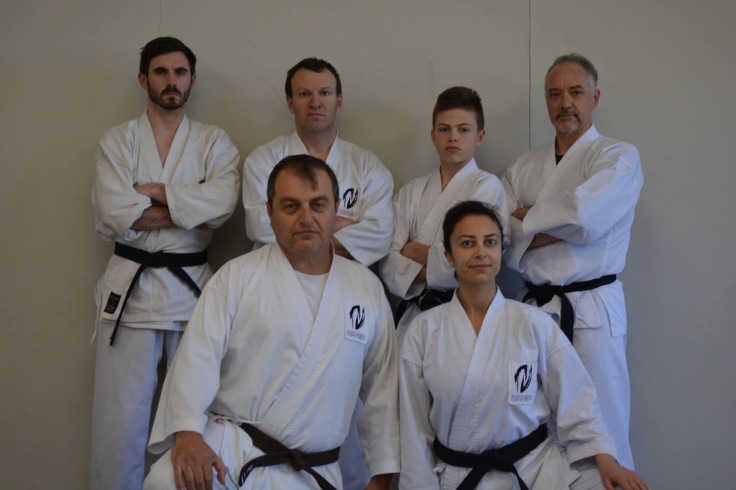Ko ancient ryu style Uchina Okinawan people di hand
古 流 沖縄 手
Kenpo Quanfa jutsu art
拳法 術
Koryu Uchinadi presents a pathway to understanding self-defence by preparing students to deal with unwarranted acts of aggression in the real world.
Koryu Uchinadi is a modern look at the classical fighting arts as interpreted by Hanshi Patrick McCarthy (9th Dan). Based upon classical Japanese tradition, while acknowledging its Okinawan heritage, KU is focused on honouring the heritage of martial arts while not living in the past.

Koryu Uchinadi is all encompassing. KU reflects the importance of functional application principles. It integrates the history of the art with key components such as human anatomy, physiology, psychology and body mechanics, while simultaneously strengthening one’s overall mental, physical and holistic conditioning.
Condition the body
Cultivate the mind
Nurture the spirit
Classes focus on:
kihon – fundamental techniques,
te-gumi – 2 person application drills,
kata – solo applications as a means of linking individual techniques into a flow drill.
All three components are required to develop and refine one’s skills to build core competency in self-defence.
The creed of KU is “bringing together like-minded people in pursuit of common goals while celebrating personal achievement and camaraderie”. Martial arts is a way of forging lifelong friendships.
Examples of KU around the world
Finland Long island Augsburg Aiki Kenpo Jujutsu
Fighting Principles
Key requirements of becoming a successful martial art practitioner are an in-depth understanding of HAPV (Habitual Acts of Physical Violence), human anatomy, body mechanics, Pre-Determined Responses, and understanding core fighting principles.
Core fighting principles include:
- Insight into the nature of violence, including the reality of its brutality and unpredictable nature, as well as the psychological and physiological impacts associated with it. This centres around the concept of awareness: of a prospective attacker, your own self-awareness and environmental awareness. (Refer to Self-defence)
- Understanding the 5 ancient machines and applying techniques to the human body
- Lever
- Wheel & axle
- Pulley
- Screw
- Wedge/ Inclined plane
- Application Formula
- Location – where you apply technique
- Tool – which body part you use (eg. fist, elbow, foot, etc.)
- Angle – The angle at which the technique is applied
- Direction – What direction the force is travelling
- Intensity – The amount of power required to get a specific result
A MUST READ ARTICLE
“An Art With Thousand Faces”
Importance of realistic training
“It’s the journey, not the destination…”
We’ve all heard this cliché a thousand times. Yet a cliché becomes common place for a reason – it can be applied to many aspects of our lives. Training in KU is no exception. Every individual differs in their mindset, capability, physical prowess and ability to learn. Not everyone is going to reach their milestones in the same way, or in the same sequence, but that’s ok. KU offers an experience where knowledge is gained via the physical application of practical skills in a way that is attainable for each person.
Training should be inward focused on self-discovery. Sun Tzu believed that “knowing oneself is the greatest battle and once you have won this battle, you have truly mastered the art”. Martial arts are a great vehicle for self-growth and self-reflection as your true opponent is yourself. The more you put in, the more you get out.
Understanding and recognising your weaknesses is the only way in which you can continue to develop and grow as an individual. Even the elite martial artists are still learning and growing both physically and mentally (maybe this is the secret of how they have got to where they have got to).
It’s worth remembering this logic also applies to oneself as who we are at 16 in both a physical and mental state, is far different from who we are at 52 years of age (it would be great to be 16 again!).
Critical thinking is a fundamental component of successful martial arts as its important to question what we are told rather than blindly accepting. Critical thinking encourages exploration through trial and error, evaluating and understanding core fundamentals. We’ve all heard a 5 year old “but why”, shouldn’t we adults ask the same?
Development and mastery of skills associated with martial arts can also be instrumental in increasing self-confidence. That’s not to say that you need to be an expert in karate – you don’t. But the sequential process used to build your skills to learn a kata or tegumi also builds confidence in your ability to do so. This can have a knock-on effect to other areas in life – by recognising you can master what looks like a complicated drill at the beginning can highlight what you can achieve when you apply yourself.
The best means to effectively protect yourself against brutal violence is through simulating acts of physical violence in a controlled training environment. Working through HAPV and the associated 2 person applications is essential in learning and understanding key fighting principles. As experience and competency increases, the intensity of training should also increase to better prepare students to develop appropriate responses, under the threat and stress of a real-life situation, to react instinctively, if ever confronted.
Students should be looking for opportunities to work through a given technique against all kinds of opponents – different size, weight, height and capabilities – to test the core principles of that technique to ensure it is effectively applied. This provides a good chance to test and explore through trial and error and refine techniques as required. With KU’s broad syllabus, individuals are always growing and obviously the more time on the mats the better.
Supplementing 2 person drills is Kata. Kata are solo templates developed to rehearse and practice defensive applications to refine one’s skillset. Kata is not designed to replace 2 person drills, rather to consolidate the important lessons already learned.









